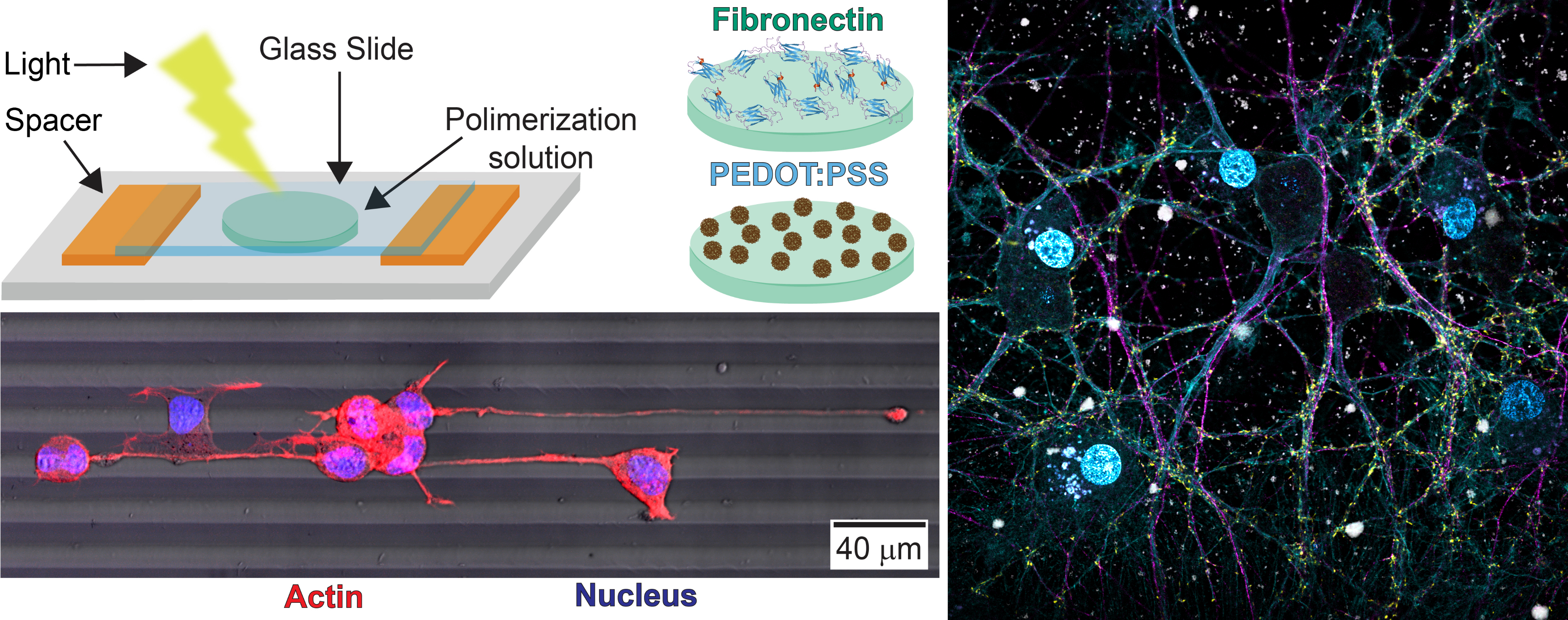Research
Smart micro and nanomaterials can serve as tools for guiding cell behavior. The Biomedical Interfaces Lab seeks to engineer soft and hybrid biomaterials with tailored physicochemical properties and investigate cell-material interactions. We aim to shed light on major cell/tissue biology issues and translate knowledge into novel neural engineering and regenerative medicine approaches and therapies for pressing biomedical problems.

Biomaterials for Neurostimulation and Neuroengineering
 Our understanding of neurons and nervous tissue is scarce. Moreover, the nervous system presents a limited capacity for spontaneous regeneration and functional recovery after injury due to trauma or disease. The lack of effective treatments for neurological conditions produces severe consequences in the quality of life of the patients and originates a serious financial burden on the health care system.
Our understanding of neurons and nervous tissue is scarce. Moreover, the nervous system presents a limited capacity for spontaneous regeneration and functional recovery after injury due to trauma or disease. The lack of effective treatments for neurological conditions produces severe consequences in the quality of life of the patients and originates a serious financial burden on the health care system.
We are developing different kinds of micro and nanomaterials to electrical and mechanical stimulation to neurons.
We intend to shed light on cell-ECM interactions and further use these materials for nerve tissue regeneration.
Selected Papers: Conductive Conjugated Polymer Nanocapacitors for Localized Electrical Neurostimulation; Cell Migration on Patterned Substrates.
Drug Delivery Vehicles and Blood-Brain Barrier

The design and synthesis of new drug delivery systems can help maximize therapeutic efficiency by transporting the drug to a specific location and releasing it passively or upon a certain stimulus. This can minimize drug toxicity and off-target side effects while improving the control over drug clearance and increasing the accumulation of the drug at the target site.
We are particularly interested in developing vehicles to cross and treat the Blood-Brain Barrier.
Selected papers: Nanoparticles for Gene Delivery across the Blood-Brain Barrier; Nanoparticles for Biomechanical Extracellular Matrix Stabilization.
Cell-ECM Interactions: Better Models for Understanding Physiology and Pathology
 The extracellular matrix is a key mediator in most intracellular events, and alterations in its mechanical, structural, and biochemical properties play a crucial role in the mechanism of most mammalian diseases.
The extracellular matrix is a key mediator in most intracellular events, and alterations in its mechanical, structural, and biochemical properties play a crucial role in the mechanism of most mammalian diseases.
Biomaterial platforms presenting dynamic, physiologically relevant biochemical, mechanical, and structural cues can be used to model cellular microenvironments to study nervous tissue mechanisms and identify new therapeutic approaches.
We intend to synthesize different three-dimensional scaffolds with various biochemical, topographic, and viscoelastic properties and study how they affect neuron cell migration, glial remodeling, angiogenesis, and mechanotransduction.
Selected Paper: Protein-Substrate Interactions and Cell Adhesion.
Laboratory Collaborations
More information to come.
